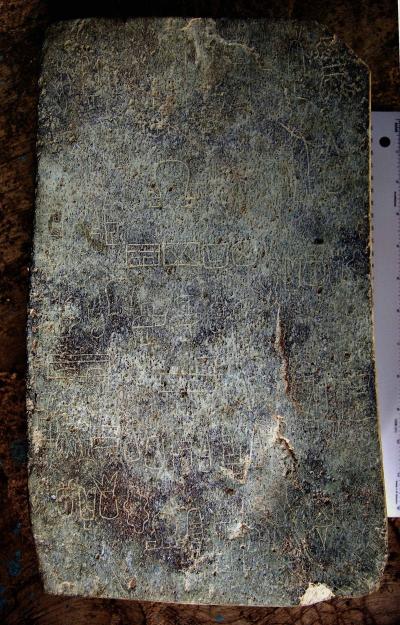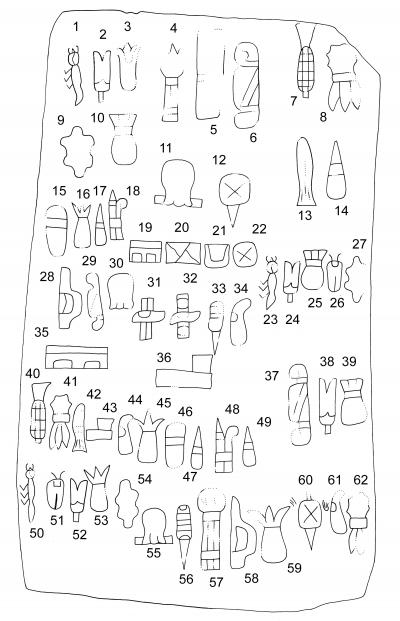
Copywriting Info
Ancient Words.
k
Uploaded: 092506
Oldest known writing ever discovered in the Americas
This is no ordinary stone that was unearthed by road builders from a gravel pit in Veracruz, Mexico in the late 1990s. It dates from between 900 to 800 years before the birth of Christ and contains what archaeologists have now determined is the oldest known writing ever discovered in the Americas.
Weighing 26 pounds, the stone is known as the "Cascajal Block" and is carved across the surface with symbols that were written by people from the Olmec civilization, believed to be the first civilization in Mesoamerica, which includes much of Mexico and Central America.
A seven-person team of American and Mexican archaeologists led by Dr. Stephen D. Houston of Brown University, found 62 distinct symbols, some of which are repeated. The writings on the stone, which were carved from the mineral serpentine, are 400 years older than what had previously been thought to be the oldest writing found in the Western Hemisphere. "This makes it, by far, the oldest writing in the Americas," said team member Dr. Richard A. Diehl, a professor of anthropology at the University of Alabama. "It's the first time in a long time that a new writing system has been discovered. There may not be a lot more undiscovered writing systems around."
The marks on the stone were made by two different instruments, Diehl says. "One of them is very sharp, and the other is much broader. They were probably both stone." The side of the block containing the writings is concave, which is an indication it may have served as a sort of blackboard, something which had been written on, erased and written upon again. This writing and erasing may be responsible for the hollowed form on one side.
While some of the stone's glyphs have been seen previously in pieces of Olmec art, others have not. "In most cases, they are not animate things," Diehl says of the symbols. Those that are recognizable include an insect, maize, a table top altar and a cross, known, from previously discovered Olmec art pieces, to be important to the people and likely representing the four compass directions. "It seems to be in rows from left to right," Diehl says of the text. "In most ancient Mexican writing systems, the glyphs start at the top and go to the bottom, so you have columns rather than rows. These seem to be in rows, and you have spaces between the rows."
Diehl says scientists may never be able to decipher the writings.
The finding was published in the journal Science, September 2006.
Back to copywriting

The Cascajal Block found in gravel pit in Veracruz, Mexico

Other Links:
http://en.wikipedia.org/wiki/
Cascajal_block 092506
http://www.eurekalert.org/
pub_releases/2006-09/
bu-owi091106.php 092506
i707
439-5323
imail@garsondesign
iwww.garsondesign
• Advertising
• • Ads
• • Billboards
• • Movie Screens
• Banners
• Billboards
• Bookmarks
• Books
• Brochures-Small
• Business Cards
• Calendars
• Cards
• Catalogs
• Client
Editable
• Copywriting
• Corporate I.D.
• Coupons
• Databases
• Direct Mail
• Display Booths
• Ethnic
• Events
• Flyers
• Forms
• Illustration
• Invitation
• Labels
• Logo
Design
• Maps
• Marketing
• Marketing
Source
• Military
• Newsletters
• Packaging
• Photography
• Photo Retouching
• Political
• Postcards
• Posters
• Presentation
• Folders
• Press Releases
• Printing
• Promotion
• Resume
• Signage
• Slides
• • Movie
Slides
• • Movie
Slide
• • Ordering
• Specialty Items
• Stationary
• Trademarking
• Translations
• T-Shirts
• Websites
• • Websites
• • FAQs
• • GDS
Banner Ads
• Yearbooks
UUpdated: Mon 9/25/06 8:39 PM
UCopyright © 2004 Garson Design Services
U